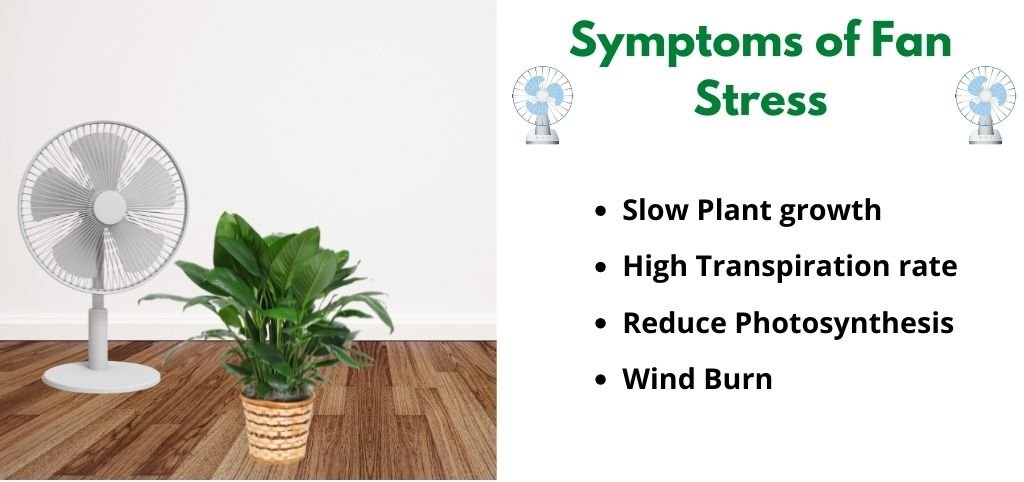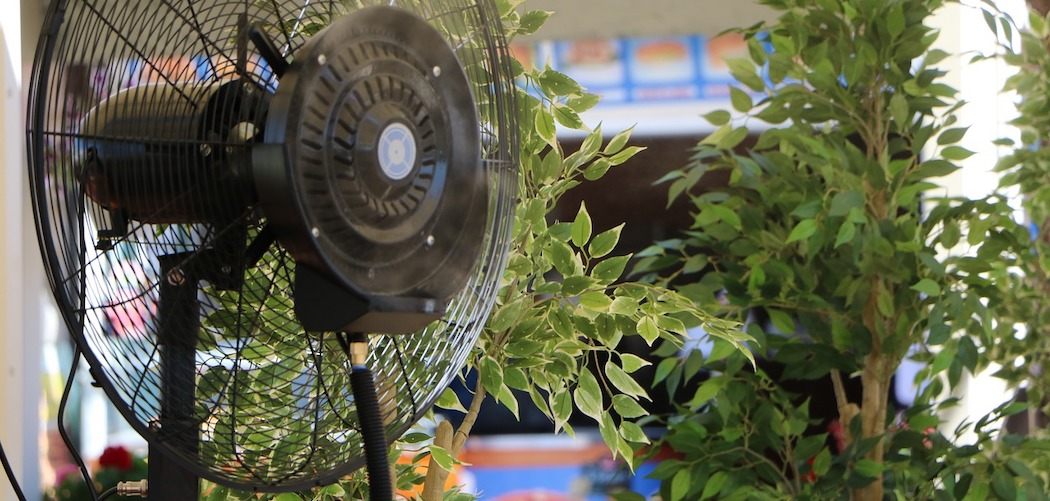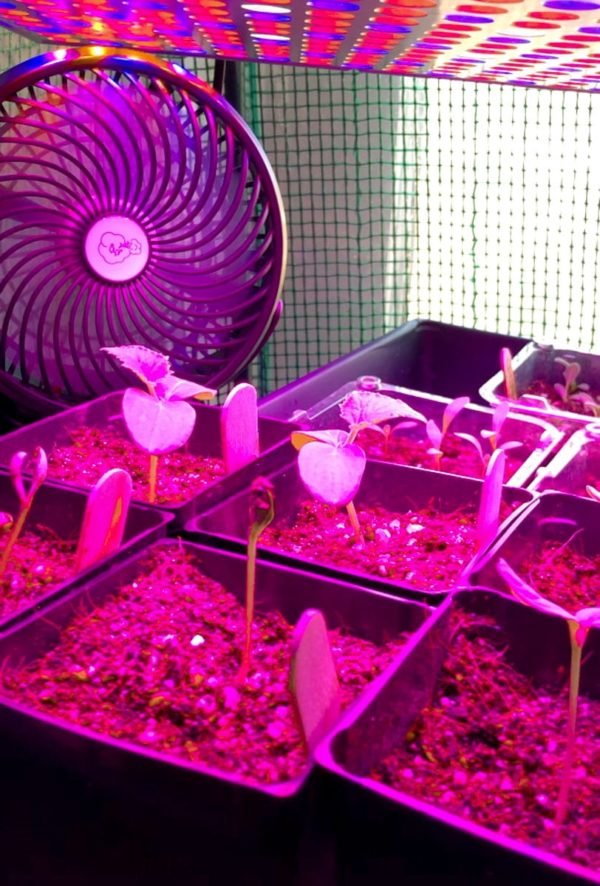Fans and air conditioners provide artificial wind for indoor plants, which can be stressful. Knowing where to place the fan or the plant will help you prevent stress.
By exposing it to an inappropriate amount of wind, a fan can stress out a plant. Wind can be blown directly onto plants by air conditioners, fixed fans, and oscillating fans, causing “windburn” and undercurling leaves. Relocating the plant or the fan is one way to prevent fan stress.
In this post, we’ve discussed how to deal with fans near plants and what you can do to maintain the health of your plants in such circumstances.
Depending on the speed, direction, and duration of operation, a fan can stress your indoor houseplants in a number of different ways.
Nearly all indoor and outdoor plants must balance five essential requirements throughout their lives:
- making food (aka photosynthesis),
- water administration,
- growth,
- reproduction,
- physical assistance.
Interestingly, each of these five essential needs can be considerably impacted by wind.
Similar to how a wind in a natural environment can, the flowing air (wind) from your fans can have a big impact on the healthy growth of your plant. It’s known as windburn.
Stress takes the appearance of wind burn. When the wind is too strong, plants react by clawing or curling the tips of their leaves under. The worst-case scenario is when leaf tips and edges turn crispy and brown.
Fans that provide artificial wind can stress indoor houseplants, changing their development patterns in a variety of ways.
Your indoor plants may get smaller, have fewer shoots, and have thicker stems and roots as a result of wind stress from fans.
Visit our post on how to take care of plants in air-conditioned spaces.
Table of Contents
Symptoms of Fan Stress:
1. Plant Growth
A swiftly moving fan can:
- decrease the growth of indoor plants,
- minimize the number of leaves and their size,
- a higher root/shoot ratio
- thicken the leaves,
- lengthen the petiole,
- enhance stem diameter & height, as well as leaf elasticity.
Your indoor houseplant’s energy will be diverted away from healthy growth and development and more toward protecting itself from the high-speed fans.
Different defense mechanisms are developed by plants to combat environmental variables, including light and wind.
Your plants will focus all of their attention and energy on growing thick leaves and roots to withstand the dragging wind if a high-speed fan is directly in front of them and is continuously blowing air into them.
Your plant may become shorter than it would otherwise be due to wind stress.
2. Transpiration Rate
The normal natural processes of your indoor houseplants can be considerably altered by frequent or infrequent blowing and ruffling of leaves, especially the rate of transpiration.
The Carnegie Institution of Washington’s Drs. E.V. Martin and F.E. Clements claim that a wind speed of up to 0.26 m.p.h. can dramatically boost transpiration rate by up to 50%.
When the wind is blowing faster than 2 mph, plants may begin to wilt slightly. Additionally, it may close the stomatal opening in the leaves of indoor plants, slowing the rate of transpiration.
In their research investigation, Drs. E.V. Martin and F.E. Clements discovered that high-speed wind can significantly enhance the rate of transpiration at night compared to during the day.
When opposed to the spring, fans that directly blow high-speed wind on indoor houseplants can have more negative effects.
3. Photosynthesis
Artificial wind from a fan can have a variety of effects on plants’ ability to synthesize oxygen, depending on the type of plant, wind temperature, and wind speed.
Indoor houseplants may need more water if high-speed fans are used.
Photosynthesis may be hampered if the area around your houseplant is cool and your fan is running nonstop, ruffling the leaves.
This occurs as a result of the leaf temperature dropping below the ideal range, the defensive mechanism of the leaf folding up, and the closing of the stomatal apertures of the leaf.
High wind speeds from the fans, as we said previously in the essay, can restrict the stomatal holes in the leaves, which could impair photosynthesis.
4. Wind Burn
Windburn can also result from leaves being blown and ruffled continuously or irregularly. One of the various challenges that plants encounter is windburn.
The plants curl the tips of their leaves in order to withstand strong winds.
High-speed fans can be quite harmful to plants, especially if you are using a non-oscillating fan.
The steady breeze pointing directly at plants will cause their leaves to curl if your fans placed in front of them don’t spin or oscillate.
My plants’ leaves, stems, and general health have been strengthened thanks to the cost-effective liquid fertilizer Purived. Clicking here will take you there!
The following remedies can assist you in avoiding any potential tension that the fans may cause:
1. Lower The Setting on The Fan
Just a little, light rustling will thicken the leaves and stems of your indoor plants. So all you have to do to avoid any stress brought on the fans is turn the fan down. Reduce your fans’ speed to a minimum.
The fans’ low to moderate wind speed would be sufficient to softly blow air over and beneath your indoor plants.
2. Change the Fan Direction
You might try facing the fan toward a wall rather than directly at the plant. This will allow you to circulate the air in your house without worrying about your plants.
3. Buy a Small Oscillating Fans
As we previously noted, fans that oscillate or don’t revolve but nevertheless blow air directly at plants can cause those plants to curl their leaves.
Buy small oscillating fans as a result. For softly fluffing the leaves and moving air around plants, small oscillating fans are suitable. But the nicest thing about them is how inexpensive and adorable they are. My personal view, LOL!
4. Move The Plant or The Fan
Altering the position of your fans is another way to prevent the wind stress they cause. Place your fan so that it isn’t blowing powerful breeze straight at your houseplants.
Plants should be moved if you are unable to move your fans for whatever reason. Put your plants in a location where they can avoid direct strong fan wind.
Yes! The plant’s stem and leaves can become thicker by using fan wind in the following ways:
As we discussed before in the text, plants create many defense mechanisms against environmental elements, particularly light and wind.
Your indoor plants’ typical development patterns will be altered by a high-speed fan.
Plants that are subjected to frequent or infrequent leaf blowing and ruffling develop robust leaves and stems. so that they can withstand the wind’s blowing force.
The wind from fans will cause the plants to grow thicker stems and leaves as well as more flexible and long petioles.
Your indoor houseplant will use more energy attempting to endure the breeze generated by fans.
But have in mind that your fans shouldn’t run faster than 2 m.p.h. Keep it reasonable. You certainly wouldn’t want your shoots and leaves to snap and fly away.
Additionally, a fan is a fantastic source for creating the required indoor ventilation.
For the process of photosynthesis, plants require a steady flow of carbon dioxide; your fan can help them by helping them obtain enough of it.
Otherwise, very little or no air movement may result in a significant drop in photosynthetic rates.
Air conditioners can also stress your houseplants, in addition to high-speed fans. Wind that is too hot or too cold is detrimental to the growth and well-being of plants.
Both have the potential to impede plant reproduction, transpiration, and photosynthesis.
The guard cells in the stomata can freeze as a result of the cold air from air conditioners, blocking the stomatal holes in the leaves and stopping transpiration.
Other channels could freeze over and become blocked, which would hinder plants’ ability to absorb water and nutrients. In other words, your indoor houseplants may suffer from the chilly air from air conditioners.
Make sure your houseplants are not facing the air conditioners directly, since this can deprive them of moisture and cause them to starve. If at all possible, put them far from your air conditioner in a corner.
However, if you see that your plants’ leaves are yellowing or drooping, take them out of the room as soon as possible.
FAQ
Why do plants need a fan?
Your plants stay cool by removing the stale, hot air and putting in fresh air with a fan. Additionally, it continuously supplies plants with carbon dioxide, which they take in through their leaves.
Does a fan help indoor plants?
Any indoor plant can benefit greatly from a fan, which circulates the air and keeps condensation and wetness on the plants at bay.
Do fans dry out plants?
A fan, or worse, an air conditioner, will deprive your plant of the humidity and room temperature it needs to grow since many plants, especially tropical ones, do not do well with dry, cold air on their foliage.
When should I put a fan on my plants?
When should seedlings be covered in a fan? We start running oscillating fans over our seedlings as soon as the seeds germinate.
How long should I keep a fan on my plants?
Keep the fan on all day long. The regular air flow will aid in the growth of stronger, more resilient seedlings in addition to assisting in disease prevention. Put your seeds in newly prepared soil that has been designed for seed starting.



